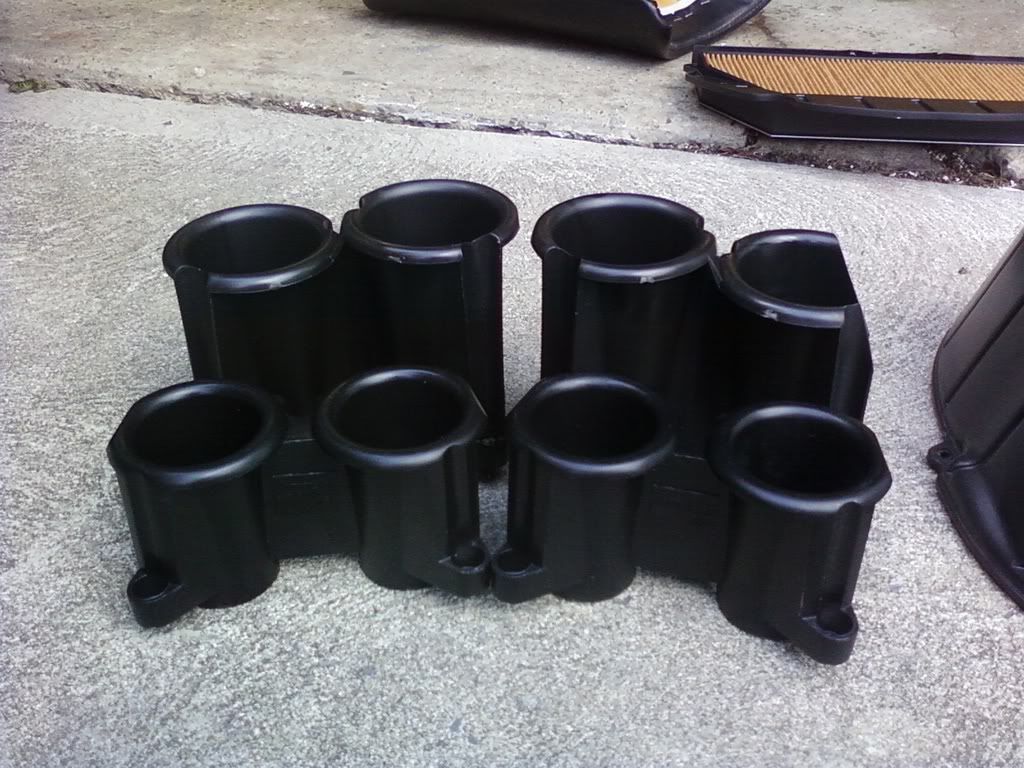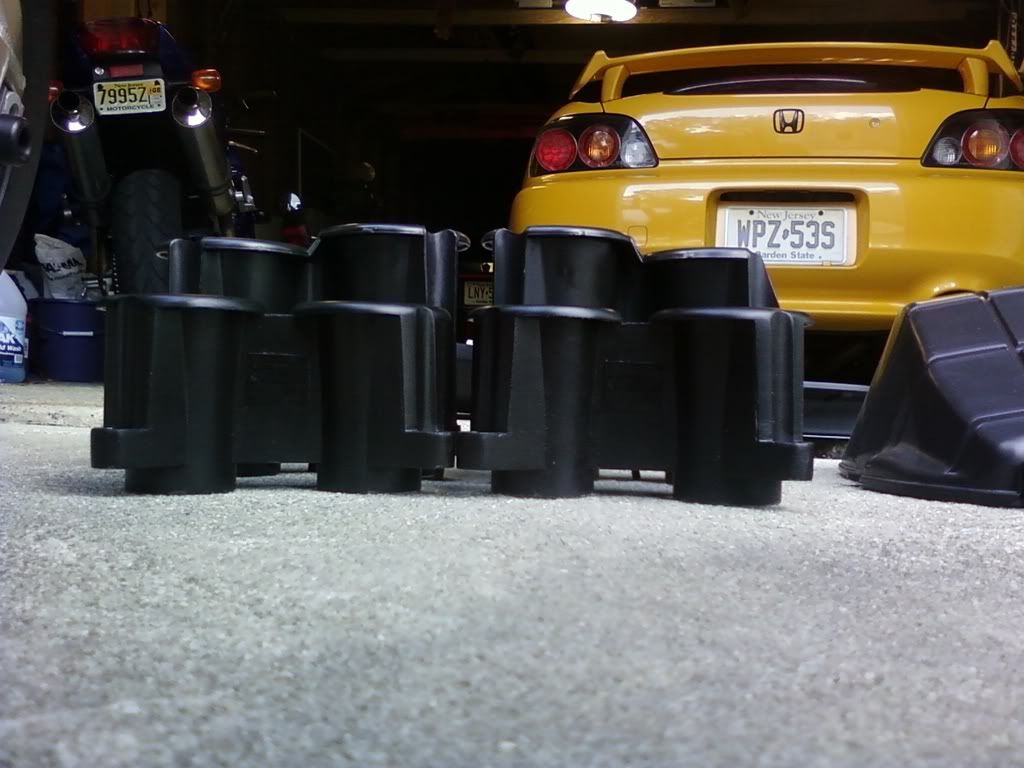
 |
 |
 |
 |
 |
 |
 |
 |
 |
|
|
|
|
#1 |
|
Chaotic Neutral
Join Date: Feb 2008
Location: Cherry Hill NJ
Moto: GV1200 Madura, Hawk gt
Posts: 13,992
|
came home from work today to find this lovely little box just chillin on my doorstep
 open her up and inside are my new shorter stacks and a couple of stickers  quick inspection reveals that these guys are made from the same quality plastic as the factory ones, sweet. looking a little closer i can see where someone hand sanded off any trace of casting flash. good, attention to quality is hard to find sometimes now lets go compare them to the stockers  good lawd! are those intakes or the business end of a pipe organ? these guys are held in place by three screws and its a gasketless design. should be easy but you know how that one goes  4 out of 6 screws were extra loose, yikes! of course, the hard to reach ones in the back are on gorilla tight...fuckers...some wd40 later and we get em out nice and easy. now we can do a nice side by side comparo 4 out of 6 screws were extra loose, yikes! of course, the hard to reach ones in the back are on gorilla tight...fuckers...some wd40 later and we get em out nice and easy. now we can do a nice side by side comparo  signifigant differences here, the FP stacks are shorter so they ought to move the meat of the powerband further up the rev range. sounds good to me, but wait! look at the #4 stack from the stockers! half the damn trumpet is missing cause of clearance issues with the stock airbox. looks like my honda came stock with only about 3 1/2 cylinders worth of airflow.  new guys in, nice and tight. bolt everything back together...check my work and its time for a test ride...woohooo! first impressions, the motor is running smoother...lots smoother, and shes feeling more powerful everywhere as well, specially on top! best part though is the sound, its subtle but shes taken on a more even scream under throttle, sounds ferocious, gotta be cause the stacks are even height. huge grins all around. anyway, in summary: price: $200 shipped...decent fit and finish.............excellent power increase..........good sound change............awesome bling.........................minimal install time.................15 minutes satisfaction................lots great mod, i'd highly recomend it to just about anyone. well, with a 954 anyway. results may differ with other bikes 
__________________
TWF Post whore #6 Last edited by Dave; 07-15-2008 at 07:21 PM.. |
|
|

|
|
|
#2 |
|
WSB Champion
Join Date: Feb 2008
Location: Springfield, MO
Posts: 7,146
|
Explain velocity stacks to me. What difference would the height make on them? Either way, isn't the same amount of air going to go through the filter and into the engine??
|
|
|

|
|
|
#3 | |
|
Chaotic Neutral
Join Date: Feb 2008
Location: Cherry Hill NJ
Moto: GV1200 Madura, Hawk gt
Posts: 13,992
|
Quote:
The intake system on a four-stroke car engine has one main goal, to get as much air-fuel mixture into the cylinder as possible. One way to help the intake is by tuning the lengths of the pipes. When the intake valve is open on the engine, air is being sucked into the engine, so the air in the intake runner is moving rapidly toward the cylinder. When the intake valve closes suddenly, this air slams to a stop and stacks up on itself, forming an area of high pressure. This high-pressure wave makes its way up the intake runner away from the cylinder. When it reaches the end of the intake runner, where the runner connects to the intake manifold, the pressure wave bounces back down the intake runner. If the intake runner is just the right length, that pressure wave will arrive back at the intake valve just as it opens for the next cycle. This extra pressure helps cram more air-fuel mix into the cylinder -- effectively acting like a turbocharger. The problem with this technique is that it only provides a benefit in a fairly narrow speed range. The pressure wave travels at the speed of sound (which depends on the density of the air) down the intake runner. The speed will vary a little bit depending on the temperature of the air and the speed it is moving, but a good guess for the speed of sound would be 1,300 feet per second (fps). Let's try to get an idea how long the intake runner would have to be to take advantage of this effect. Let's say the engine is running at 5,000 rpm. The intake valve opens once every two revolutions (720 degrees), but let's say they stay open for 250 degrees. That means that there are 470 degrees between when the intake valve closes and when it opens again. At 5,000 rpm it will take the engine 0.012 seconds to turn one revolution, and 470 degrees is about 1.31 revolutions, so it takes 0.0156 seconds between when the valve closes and when it opens again. At 1,300 fps multiplied by 0.0156 seconds, the pressure wave would travel about 20 feet. But, since must go up the intake runner and then come back, the intake runner would only have to be half this length or about 10 feet. Two things become apparent after doing this calculation: 1. The tuning of the intake runner will only have an effect in a fairly narrow RPM range. If we redo the calculation at 3,000 rpm, the length calculated would be completely different. 2. Ten feet is too long. You can't fit pipes that long under the hood of a car very easily. There is not too much that can be done about the first problem. A tuned intake has its main benefit in a very narrow speed range. But there is a way to shorten the intake runners and still get some benefit from the pressure wave. If we shorten the intake runner length by a factor of four, making it 2.5 feet, the pressure wave will travel up and down the pipe four times before the intake valve opens again. But it still arrives at the valve at the right time. There are a lot of intricacies and tricks to intake systems. For instance, it is beneficial to have the intake air moving as fast as possible into the cylinders. This increases the turbulence and mixes the fuel with the air better. One way to increase the air velocity is to use a smaller diameter intake runner. Since roughly the same volume of air enters the cylinder each cycle, if you pump that air through a smaller diameter pipe it will have to go faster. The downside to using smaller diameter intake runners is that at high engine speeds when lots of air is going through the pipes, the restriction from the smaller diameter may inhibit airflow. So for the large airflows at higher speeds it is better to have large diameter pipes. Some carmakers attempt to get the best of both worlds by using dual intake runners for each cylinder -- one with a small diameter and one with a large diameter. They use a butterfly valve to close off the large diameter runner at lower engine speeds where the narrow runner can help performance. Then the valve opens up at higher engine speeds to reduce the intake restriction, increasing the top end power output.
__________________
TWF Post whore #6 |
|
|
|

|
|
|
#4 |
|
Chaotic Neutral
Join Date: Feb 2008
Location: Cherry Hill NJ
Moto: GV1200 Madura, Hawk gt
Posts: 13,992
|
interesting, i kinda expected more responses and maybe a discussion, eh whatever. i know you guys are more into software upgrades than hardware ones. still, im planning to finish the exhaust, add an air filter and a pcIII and have the whole thing tuned by ricky. should be fun getting there

__________________
TWF Post whore #6 |
|
|

|
|
|
#5 |
|
WSB Champion
Join Date: Feb 2008
Location: Springfield, MO
Posts: 7,146
|
Thanks a ton man. Sounds pretty interesting.
|
|
|

|
|
|
#6 |
|
flyin high
Join Date: Mar 2008
Location: cali
Moto: 10speed huffy w/cards in the spokes
Posts: 2,318
|
i run stacks, stacks are great to tune with...
not much to discuss tho, easy install, pretty straightforward explanation...u left no room for discussion lol, it was too gd. ill ask this tho-is the engine offset in the frame? seems like if u had to cut one for clearance, the other one should have to be cut too. oh yea, does the opening in the base of yours perfectly match the opening of the intake? as far as stacks in general-whats with 2 of the stacks being longer? i see some guys put the short ones on the inside, other guys put the long ones on the inside. doesnt apply to your 954 cuz they are equal height, but most stack kits ive seen are like that.
__________________
"Racing Is Life, Everything Before and After is Just Waiting" Steve McQueen Last edited by Dnyce; 07-16-2008 at 02:06 AM.. |
|
|

|
|
|
#7 |
|
Trip's Assistant
 Join Date: Feb 2008
Location: Imported from Detroit
Moto: 2009 HD Street Classic
Posts: 12,149
|
Remember boys...
your motor is nothing more than a big air pump. air/fuel in air out The quicker you can get the air in and out, the more power you can make. Simple. |
|
|

|
 |
| Bookmarks |
| Thread Tools | |
| Display Modes | |
|
|